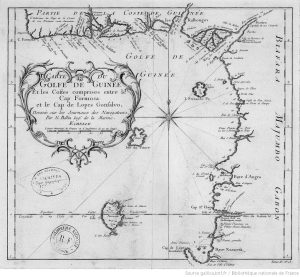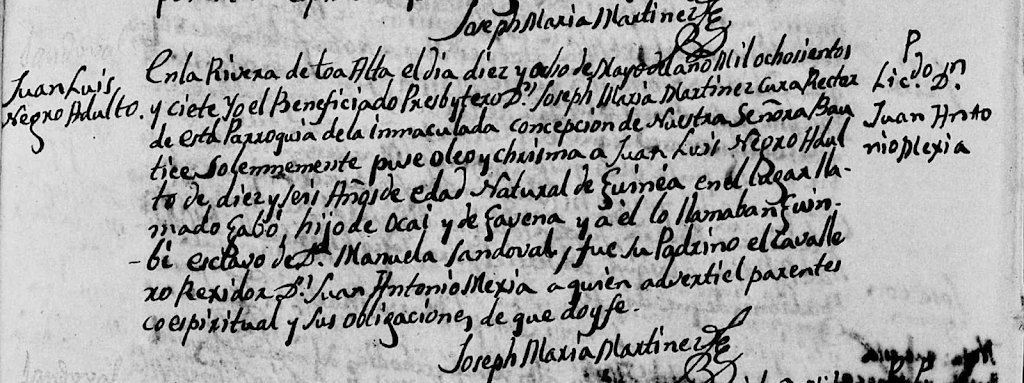I wanted to share this record I found while searching the Toa Alta baptism records again. In all my years of researching, I have rarely come across an entry this detailed for a slave’s baptism. Four years ago, I posted “
Whispers of the Past” where certain entries for slaves in the Registry of 1872 contained the name of their parents. This is first time I am seeing a church record include so much information for a slave.
Below is a transcription of the document above.
Transcription: En la Rivera de Toa Alta el día diez y ocho de mayo del año mil ochocientos y siete yo el beneficiado presbiterio Don Joseph María Martínez Cura Rector de esta parroquia de la Inmaculada Concepción de Nuestra Señora bauticé solemnemente puse oleo y crisma a Juan Luis negro adulto de diez y seis años de edad natural de Guinea en el lugar llamado Gabó, hijo de Ocai y de Gavena y a él lo llamaban Guinbi, esclavo de Doña Manuela Sandoval, fue su padrino el caballero regidor Don Juan Antonio Mexía a quien advertí el parentesco espiritual y sus obligaciones, de que doy fe. [firmado] Joseph María Martínez.
The main information to discern from above is that on the 18th of May 1807, Juan Luis, a black adult of 16 years of age, native of Guinea from the place of “Gabó” son of Ocai and Gavena who was previously known as Guinbi, slave of Manuela Sandoval, was baptized in the church of Toa Alta, Puerto Rico.
Interestingly enough, three other slaves belonging to Manuela Sandoval are also baptized in 1807 along with Juan Luis, none of them however have as much information to them as Juan Luis. The slaves are as follows:
Juan Manuel, esclavo de Manuela Sandoval, adulto, natural de Guinea
Andrés Antonio, esclavo de Manuela Sandoval, adulto, natural de Guinea
Manuel Antonio, esclavo de Manuela Sandoval, adulto, natural de Guinea
Besides stating that they were “natives of Guinea” no ages or parents’ names are mentioned. These type of entries are more common amongst slaves and it’s interesting that Juan Luis’ entry has so much detail.
Why only Juan Luis?
It is possible that Juan Luis was quick to learn Spanish and was allowed to share his information when baptized. I’m not sure if Manuela Sandoval was kind enough to let him share this information or if Joseph María Martínez asked him these questions himself when he was baptized. It is likely that Juan Luis was brought to Puerto Rico that year or maybe the previous year and was well aware of who he was, where he was from, and the names of his parents. Potentially even his age is maybe correct seeing as how he was the only slave of four to mention an age. This would mean that Guinbi, later known as Juan Luis, was likely born around the year 1791.
“El lugar Gabó”
My guess would be that Guinbi was originally from the country today known as Gabon (Gabón in Spanish). From my understanding of the 17-18th century slave trade, most of the western area was known as “Guinea” and so it included various countries that today are: Guinea, Equatorial Guinea, Gabon, Ghana, Togo, Nigeria, Cameroon, and various islands and other countries as well. A map of the times gives us a better idea of the extension of this area known as the “
Gulf of Guinea“.
Unfortunately, this is the closest we are to knowing where Guinbi was from, no town is mentioned and the fact that his baptism includes the actual country and his parents’ names is a feat in and of itself.
Guinbi, son of Ocai and Gavena
Since we are dealing with Spanish orthography, we are not sure the correct or accurate spelling of their names. For example, the “u” is used after the “g-” in Spanish but this might not be the case in other languages, the “n” might be a “m” giving us something like Ginbi or Gimbi. His father’s name might take a “k” instead of a “c” and the “a” might be a more “e” sound, something along the lines of Okai or Okei. Lastly, his mother’s name could take “b” instead of a “v” since Spanish doesn’t distinguish the two giving us Gabena. And who’s to say these weren’t short versions of longer names as well!
The three main indigenous languages in Gabon are Fang, Mbere, and Sira – all being Bantu languages. I would imagine their names fall under one of these languages but of course there is always the possibility it doesn’t. An ethnographic and linguistic analysis of these names and cross referencing other sources of the time which help to distinguish African names in Spanish orthography would be helpful to discover their Gabonese names.
Conclusions
It would be interesting to follow Juan Luis’ life and see what became of him in Puerto Rico. How long did he stay enslaved? Does he end up marrying and having children in Puerto Rico? Does he have descendants out there? If only these type of detailed records existed for all of our enslaved ancestors!



